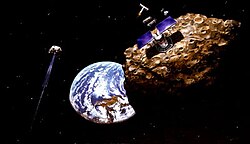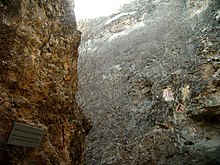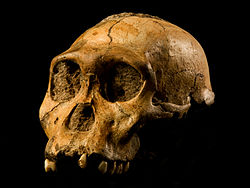From Wikipedia, the free encyclopedia
Asteroid mining refers to the possibility of exploiting raw materials from asteroids and other minor planets, including near-Earth objects.[1] Minerals and volatiles could be mined from an asteroid or spent comet then taken back to Earth or used in space for construction materials. Materials that could be mined or extracted include iron, nickel, titanium for construction, water, and oxygen to sustain the lives of prospector-astronauts on site, as well as hydrogen and oxygen for use as rocket propellant. In space exploration, using resources gathered while on a journey is referred to as in-situ resource utilization.
Purpose
Based on known terrestrial reserves and growing consumption in developing countries along with excessive exploitation by developed countries, there is speculation that key elements needed for modern industry and food production, including phosphorus, antimony, zinc, tin, silver, lead, indium, gold, and copper, could be exhausted on Earth within 50–60 years.[2] In response, it has been suggested that platinum, cobalt and other valuable elements from asteroids may be mined and sent to Earth for profit, used to build solar-power satellites and space habitats,[3][4] and water processed from ice to refuel orbiting propellant depots.[5][6][7]In fact, all the gold, cobalt, iron, manganese, molybdenum, nickel, osmium, palladium, platinum, rhenium, rhodium, ruthenium, and tungsten mined from Earth's crust, and that are essential for economic and technological progress, came originally from the rain of asteroids that hit Earth after the crust cooled.[8][9][10] This is because although asteroids and Earth accreted from the same starting materials, Earth's relatively stronger gravity pulled all heavy siderophilic (iron-loving) elements into its core during its molten youth more than four billion years ago.[10] This left the crust depleted of such valuable elements[10] until asteroid impacts re-infused the depleted crust with metals (some flow from core to surface does occur, e.g. at the Bushveld Igneous Complex, a famously rich source of platinum-group metals).
In 2006, the Keck Observatory announced that the binary Jupiter trojan 617 Patroclus,[11] and possibly large numbers of other Jupiter trojans, are likely extinct comets and consist largely of water ice. Similarly, Jupiter-family comets, and possibly near-Earth asteroids that are extinct comets, might also economically provide water. The process of in-situ resource utilization—using materials native to space for propellant, tankage, radiation shielding, and other high-mass components of space infrastructure—could lead to radical reductions in its cost.[1]
Ice would satisfy one of two necessary conditions to enable "human expansion into the Solar System" (the ultimate goal for human space flight proposed by the 2009 "Augustine Commission" Review of United States Human Space Flight Plans Committee): physical sustainability and economic sustainability.[12]
From the astrobiological perspective, asteroid prospecting could provide scientific data for the search for extraterrestrial intelligence (SETI). Some astrophysicists have suggested that if advanced extraterrestrial civilizations employed asteroid mining long ago, the hallmarks of these activities might be detectable.[13][14][15]
Asteroid selection
| Mission | Δv |
|---|---|
| Earth surface to LEO | 8.0 km/s |
| LEO to near-Earth asteroid | 5.5 km/s[note 1] |
| LEO to lunar surface | 6.3 km/s |
| LEO to moons of Mars | 8.0 km/s |
Near-Earth asteroids are considered likely candidates for early mining activity. Their low Δv makes them suitable for use in extracting construction materials for near-Earth space-based facilities, greatly reducing the economic cost of transporting supplies into Earth orbit.[16]
The table at right shows a comparison of Δv requirements for various missions. In terms of propulsion energy requirements, a mission to a near-Earth asteroid compares favorably to alternative mining missions.
An example of a potential target for an early asteroid mining expedition is 4660 Nereus.[17] This body has a very low Δv compared to lifting materials from the surface of the Moon. However it would require a much longer round-trip to return the material.
Multiple types of asteroids have been identified but the three main types would include the C-type, S-type, and M-type asteroids.
- C-type asteroids have a high abundance of water which is not currently of use for mining but could be used in an exploration effort beyond the asteroid. Mission costs could be reduced by using the available water from the asteroid. C-type asteroids also have a lot of organic carbon, phosphorus, and other key ingredients for fertilizer which could be used to grow food.[18]
- S-type asteroids carry little water but look more attractive because they contain numerous metals including: nickel, cobalt and more valuable metals such as gold, platinum and rhodium. A small 10-meter S-type asteroid contains about 650,000 kg (1,433,000 lb) of metal with 50 kg (110 lb) in the form of rare metals like platinum and gold.[18]
- M-type asteroids are rare but contain up to 10 times more metal than S-types[18]
Asteroid cataloging
The B612 Foundation is a private nonprofit foundation with headquarters in the United States, dedicated to protecting Earth from asteroid strikes. As a non-governmental organization it has conducted two lines of related research to help detect asteroids that could one day strike Earth, and find the technological means to divert their path to avoid such collisions.The foundation's current goal is to design and build a privately financed asteroid-finding space telescope, Sentinel, to be launched in 2017–2018. The Sentinel's infrared telescope, once parked in an orbit similar to that of Venus, will help identify threatening asteroids by cataloging 90% of those with diameters larger than 140 metres (460 ft), as well as surveying smaller Solar System objects.[19][20][21]
Data gathered by Sentinel will be provided through an existing scientific data-sharing network that includes NASA and academic institutions such as the Minor Planet Center in Cambridge, Massachusetts. Given the satellite's telescopic accuracy, Sentinel's data may prove valuable for other possible future missions, such as asteroid mining.[20][21][22]
Mining considerations
There are three options for mining:[16]- Bring raw asteroidal material to Earth for use.
- Process it on-site to bring back only processed materials, and perhaps produce propellant for the return trip.
- Transport the asteroid to a safe orbit around the Moon, Earth or to the ISS.[7] This can hypothetically allow for most materials to be used and not wasted.[4] (see Methods for asteroid retrieval or catching)
Mining operations require special equipment to handle the extraction and processing of ore in outer space.[16] The machinery will need to be anchored to the body,[citation needed] but once in place, the ore can be moved about more readily due to the lack of gravity. Docking with an asteroid can be performed using a harpoon-like process, where a projectile penetrates the surface to serve as an anchor then an attached cable is used to winch the vehicle to the surface, if the asteroid is rigid enough for a harpoon to be effective.[23]
Due to the distance from Earth to an asteroid selected for mining, the round-trip time for communications will be several minutes or more, except during occasional close approaches to Earth by near-Earth asteroids. Thus any mining equipment will either need to be highly automated, or a human presence will be needed nearby.[16] Humans would also be useful for troubleshooting problems and for maintaining the equipment. On the other hand, multi-minute communications delays have not prevented the success of robotic exploration of Mars, and automated systems would be much less expensive to build and deploy.[24]
Technology being developed by Planetary Resources to locate and harvest these asteroids has resulted in the creation of 3 different types of satellites.
- Arkyd Series 100 (The Leo Space telescope) Less expensive instrument that will be used to find, analyze, and see what resources are available on nearby asteroids.[18]
- Arkyd Series 200 (The Interceptor) Satellite that would actually land on the asteroid to get a closer analysis of the available resources.[18]
- Arkyd Series 300 (Rendezvous Prospector) Satellite developed for research and finding resources deeper in space.[18]
- FireFlies are launched in waves of three nearly identical spacecraft to different targets in inexpensive CubeSat form factors to rendezvous and examine candidate asteroids for their resource value.[25]
- DragonFlies also are launched in waves of three nearly identical spacecraft to gather small samples (5–10 kg) and return them to Earth for detailed analysis of their value.[25]
- Harvestors voyage out to confirmed high-value asteroid to gather hundreds of tons of material for return to high Earth orbit for processing into products useful for high-value in-space markets.[26]
Extraction techniques
Surface mining
On some types of asteroids, material may be scraped off the surface using a scoop or auger, or for larger pieces, an "active grab."[16] There is strong evidence that many asteroids consist of rubble piles,[27] making this approach possible.Shaft mining
A mine can be dug into the asteroid, and the material extracted through the shaft. This requires precise knowledge to engineer accuracy of astro-location under the surface regolith and a transportation system to carry the desired ore to the processing facility.Magnetic rakes
Asteroids with a high metal content may be covered in loose grains that can be gathered by means of a magnet.[16][28]Heating
For volatile materials in extinct comets, heat can be used to melt and vaporize the matrix.[16][29]Self-replicating machines
A 1980 NASA study entitled Advanced Automation for Space Missions proposed a complex automated factory on the Moon that would work over several years to build a copy of itself.[30]Exponential growth of factories over many years could refine large amounts of lunar regolith. Since 1980 there has been major progress in miniaturization, nanotechnology, materials science, and additive manufacturing.
The power of self-replication is compelling. For example, a 1 kg solar-powered self-replicating machine that takes one month to make a copy of itself would, after just two and a half years (30 doublings), refine over one billion kilograms of asteroidal material without any human intervention. Ten months later you would have one trillion kg of whatever metal(s) are used to make the devices, which could then be "harvested" at any time. No large mass of equipment need be delivered to the asteroid; in effect, only the information that went into designing the device plus the 1 kg device itself.
Asteroid prospects
A class of easily recoverable objects (EROs) was identified by a group of researchers in 2013. Twelve asteroids made up the initially identified group, all of which could be potentially mined with present-day rocket technology. Of 9000 asteroids searched in the NEO database, these twelve could all be brought into an Earth-accessible orbit by changing their velocity by less than 500 meters per second (1,800 km/h; 1,100 mph). The dozen asteroids range in size from 2 to 20 meters (10 to 70 ft).[31]Proposed mining projects
On April 24, 2012 a plan was announced by billionaire entrepreneurs to mine asteroids for their resources. The company is called Planetary Resources and its founders include aerospace entrepreneurs Eric Anderson and Peter Diamandis. Advisers include film director and explorer James Cameron and investors include Google's chief executive Larry Page and its executive chairman Eric Schmidt.[1][32] They also plan to create a fuel depot in space by 2020 by using water from asteroids, which could be broken down in space to liquid oxygen and liquid hydrogen for rocket fuel. From there, it could be shipped to Earth orbit for refueling commercial satellites or spacecraft.[1] The plan has been met with skepticism by some scientists who do not see it as cost-effective, even though platinum and gold are worth nearly £35 per gram (approximately $1,800 per troy ounce). An upcoming NASA mission (OSIRIS-REx) to return just 60 g (two ounces) of material from an asteroid to Earth will cost about $1 billion USD.[1] Planetary Resources admits that, in order to be successful, it will need to develop technologies that bring the cost of space flight down. Planetary Resources also expects that the construction of "space infrastructure" will help to reduce long-term running costs.For example, fuel costs can be reduced by extracting water from asteroids and converting it to hydrogen using solar energy. In theory, hydrogen fuel mined from asteroids costs significantly less than fuel from Earth due to high costs of escaping Earth's gravity. If successful, investment in "space infrastructure" and economies of scale could reduce operational costs to levels significantly below NASA's upcoming (OSIRIS-REx) mission.[33]
Another similar venture, called Deep Space Industries, was started by David Gump, who had founded other space companies.[34] The company hopes to begin prospecting for asteroids suitable for mining by 2015 and by 2016 return asteroid samples to Earth.[35] By 2023 Deep Space Industries plans to begin mining for asteroids.[36]
Deep Space Industries won a contract to design a bitcoin spacecraft and associated constellation to broadcast the latest completed bitcoin block in April 2014.[37] NASA has awarded the company two contracts for analysis and advice on the space agency's Asteroid Redirect Mission in June 2014.[38]
At ISDC-San Diego 2013,[39] Kepler Energy and Space Engineering (KESE,llc) also announced it was going to mine asteroids, using a simpler, more straightforward approach: KESE plans to use almost exclusively existing guidance, navigation and anchoring technologies from successful missions like the Rosetta/Philae, Dawn, and Hyabusa's Muses-C and current NASA Technology Transfer tooling to build and send a 4-module Automated Mining System (AMS) to a small asteroid with a simple digging tool to collect ~40 tons of asteroid regolith and bring each of the four return modules back to low Earth orbit (LEO) by the end of the decade. Small asteroids are expected to be loose piles of rubble, therefore providing for easy extraction.
In September 2012, the NASA Institute for Advanced Concepts (NIAC) announced the Robotic Asteroid Prospector project, which will examine and evaluate the feasibility of asteroid mining in terms of means, methods, and systems.[40]
Economics
Currently, the quality of the ore and the consequent cost and mass of equipment required to extract it are unknown and can only be speculated. Some economic analyses indicate that the cost of returning asteroidal materials to Earth far outweighs their market value, and that asteroid mining will not attract private investment at current commodity prices and space transportation costs.[41][42] Other studies suggest large profit by using solar power.[43][44] Potential markets for materials can be identified and profit generated if extraction cost is brought down. For example, the delivery of multiple tonnes of water to low Earth orbit for rocket fuel preparation for space tourism could generate a significant profit.[45]In 1997 it was speculated that a relatively small metallic asteroid with a diameter of 1.6 km (0.99 mi) contains more than $20 trillion USD worth of industrial and precious metals.[6][46] A comparatively small M-type asteroid with a mean diameter of 1 kilometer (0.62 mi) could contain more than two billion metric tons of iron–nickel ore,[47] or two to three times the annual production of 2004.[48] The asteroid 16 Psyche is believed to contain 1.7×1019 kg of nickel–iron, which could supply the world production requirement for several million years. A small portion of the extracted material would also be precious metals.
Although Planetary Resources says that platinum from a 30-meter long asteroid is worth 25–50 billion USD,[49] an economist remarked that any outside source of precious metals could lower prices sufficiently to possibly doom the venture by rapidly increasing the available supply of such metals.[50]
Development of an asteroid-orbit manipulation infrastructure could offer a large return on investment.[51] However, astrophysicists Carl Sagan and Steven J. Ostro raised the concern that altering the trajectories of asteroids in nearby interplanetary space could cause a catastrophic collision with Earth. These scientists concluded[when?] that stringent controls on the misuse of orbit-engineering technology be instituted.[by whom?][51][52][53]
Scarcity
Scarcity is a fundamental economic problem of humans having seemingly unlimited wants in a world of limited resources. Asteroid mining has the potential to provide nearly unlimited resources, which could eliminate scarcity for those materials.[citation needed] Earth's resources are not infinite.The idea of exhausting resources is not new, Thomas Malthus wrote in 1798 that, because resources are ultimately limited, the exponential growth in a population would result in falls in income per capita until poverty and starvation would result as a constricting factor on population.[54] Malthus's analysis was based on two types of reserves on Earth, including proven and conditional reserves.[citation needed] These make up the group of measured reserves that is estimated to contain about 20% of Earth's deposits.[clarification needed]
- Proven reserves are deposits of mineral resources that are already discovered and known to be economically extractable under present or similar demand, price and other economic and technological conditions.[54]
- Conditional reserves are discovered deposits that are not yet economically viable.[citation needed]
- Indicated reserves are less intensively measured deposits whose data is derived from surveys and geological projections. Hypothetical reserves and speculative resources make up this group of reserves. Inferred reserves are deposits that have been located but not yet exploited.[54]
Financial feasibility
Space ventures are high-risk, with long lead times and heavy capital investment, and that is no different for asteroid-mining projects. These types of ventures could be funded through private investment or through government investment. If a government venture were to be sought, maximizing its cost–benefit ratio and financial returns are a must. For a commercial venture it can be highly profitable as long as the revenue earned is greater than total costs (costs for extraction and costs for marketing).[55] The costs involving an asteroid-mining venture have been estimated to be around $100 billion US.[55]There are six categories of cost considered for an asteroid mining venture:[55]
- Research and development costs
- Exploration and prospecting costs
- Construction and infrastructure development costs
- Operational and engineering costs
- Environmental costs
- Time cost
The payback period and the high risk involved make asteroid mining a less competitive venture compared to terrestrial projects. Launching costs may be the most significant, which can only lower over time through increased competition and technological innovation. Asteroid mining will become more viable when fixed costs lower due to development in infrastructure.[citation needed]
In fiction
The first mention of asteroid mining in science fiction is apparently Garrett P. Serviss' story Edison's Conquest of Mars, New York Evening Journal, 1898.[56][57]The 1979 film Alien, directed by Ridley Scott, is about the crew of the Nostromo, a commercially operated spaceship on a return trip to Earth hauling a refinery and 20 million tons of mineral ore mined from an asteroid. C. J. Cherryh's novel, Heavy Time focuses on the plight of asteroid miners in the Alliance-Union universe, while Moon is a 2009 British science fiction drama film depicting a lunar facility that mines the alternative fuel helium-3 needed to provide energy on Earth. It was notable for its realism and drama, winning several awards internationally.[58][59][60]
In several science fiction video games, asteroid mining is a possibility. For example, in the space-MMO, EVE Online, asteroid mining is a very popular career, due to its simplicity.[61][62][63]
Gallery
-
Artist's concept of an asteroid moved by a space tether
-
A future space telescope designed by Planetary Resources company to find asteroids












